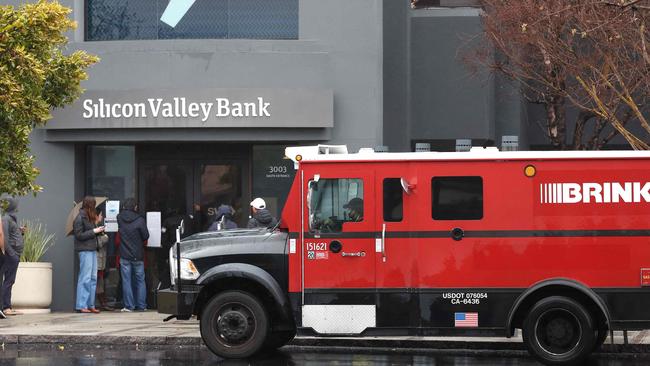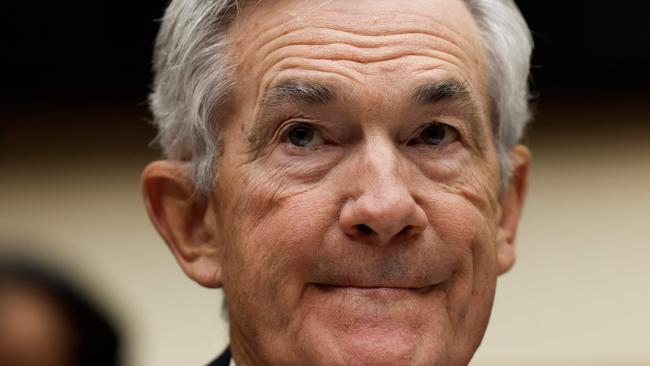Why did SVB collapse and will the damage reach Australia?
The collapse of Silicon Valley Bank in the US is a classic bank run that could lead to rate rises being paused. Here’s how it happened and what it means for you.

The collapse of Silicon Valley Bank (SVB), the second-largest bank failure in US history, has raised concerns a new global financial downturn is upon us as interest rates continue to rise and anxious investors consider withdrawing cash.
But how did the SVB collapse happen, what did it mean for Australians and Australian companies, and is this the start of another economic crisis?
Here are your questions answered.
How big is it?
The failure of SVB is notable because it is the second-largest collapse behind Lehman Brothers – which infamously sparked the 2008 Global Financial Crisis.
SVB’s asset base represents about $320bn, which is roughly the combined value of Bendigo Bank, Suncorp and Bank of Queensland.
Or another way of looking at it is half the size of an ANZ.
When it comes to the value of deposits, SVB was the 14th-biggest US bank, with about $US290bn ($437.2bn) in deposits.
Fearing a similar situation, US regulators have now stepped in to shut New York-based Signature Bank, which had $US88.59bn ($133.9bn) in deposits as of December.
Comparatively, Australia’s largest bank CBA held $877bn, which is about $US580.2bn, in total group deposits as of December.
How did it happen?
Industry experts describe the collapse as a “classic bank run”.
SVB had a large focus on lending and banking for Silicon Valley tech firms, global start-ups and venture capital.
As NAB analyst Ray Atrill notes, SVB recorded strong growth in deposits during the Covid-19 pandemic and had invested those deposits in fixed-income securities – mainly Treasuries and mortgage-backed securities.

However, as interest rates rose the market value of those assets fell.
Adding to the pain, recent economic challenges resulted in struggling tech firms slowly withdrawing funds.
To meet the significant amount of cash leaving the bank, SVB on Wednesday was forced to sell $US21bn ($31.9bn) worth of bonds at a loss of $US1.8bn.
A push to raise $2.25bn and cover the losses then failed.
Investors, spooked by the situation, attempted to pull $42bn from the bank on Thursday – a classic bank run that ensured its collapse.
Is this the start of the next GFC?
While the high-speed collapse of the California bank that until the weekend many Australians had never heard of will rock an already beaten up tech sector it’s not a Lehman Brothers moment, Eric Johnston writes.
When a bank goes under it represents the equivalent of bomb going off, with damage hitting those closest to it.

Experts are so far suggesting the collateral damage of the SVB fallout will be limited, but cautiously saying it will take time to know if it’s an isolated issue or whether other smaller banks may also find themselves similarly exposed.
In this case, tech companies and venture capital funds were among the biggest customers.
In 2008 when Lehman Brothers collapsed it counted every other Wall Street bank and major main street banks as a counterparts to its toxic securities book and the destruction was felt around the world.
The Australian banking regulator on Monday said it was “intensifying supervision” of the domestic banking sector in the wake of the collapse.
“While the Australian banking industry has limited connections with the US-based Silicon Valley Bank, APRA is intensifying supervision of the local banking industry and is seeking more information from them on any potential impacts,” a spokesman said.
How will it affect me?
Oddly, the collapse of SVB could deliver relief from the persistent pain inflicted by the Reserve Bank of Australia on mortgage holders.
Betashares chief economist David Bassanese believes the bank’s failure could scare the RBA and the almighty Federal Reserve into pausing its rate rises.
“Depending on the fallout in the next few days, moreover, the mayhem will likely be enough to encourage the RBA to pause at the April meeting also,” he said.
However, those celebrating a pause in rate hikes should take Mr Bassanese’s warning, the lingering fear of financial contagion and a collapse in credit may be a worse outcome than a rate rise.
Notably, the odds of a pause in rate hikes by the RBA at its April meeting have soared to 60 per cent, according to Bloomberg.
Are Australian companies impacted?
Several Australian companies on Monday morning revealed they have many millions of dollars tied-up with SVB.

Thankfully no company has raised serious concerns about its ability to survive following the collapse.
Nitro Software says it has about $US12.18 ($18m) of its global cash reserves on deposit at SVB while engineering company SiteMinder said its exposure to SVB and UK subsidiary SVBUK included cash holdings of up to $10m.
Tech Council of Australia chief executive Kate Pounder said the group had also started to assess how the collapse would affect local businesses.
“Our preliminary sense is that the majority of local Australian firms are not directly impacted, although we are aware of some who have been, and we want to work with them to support them,” she said.
What is being done?
US Federal regulators rolled out emergency measures on Sunday night (US time) to stem potential spillovers from Friday’s swift collapse of SVB and revealed measures to backstop all depositors.

The who’s who of the US financial sector – including Treasury Secretary Janet Yellen and Federal Reserve Chair Jerome Powell – used a joint statement to declare depositors at SVB would have access to all of their money on Monday.
“Depositors will have access to all of their money starting Monday, March 13. No losses associated with the resolution of Silicon Valley Bank will be borne by the taxpayer,” the group said.
The move is also aimed at preventing similar uncertainty plaguing other smaller institutions.







To join the conversation, please log in. Don't have an account? Register
Join the conversation, you are commenting as Logout